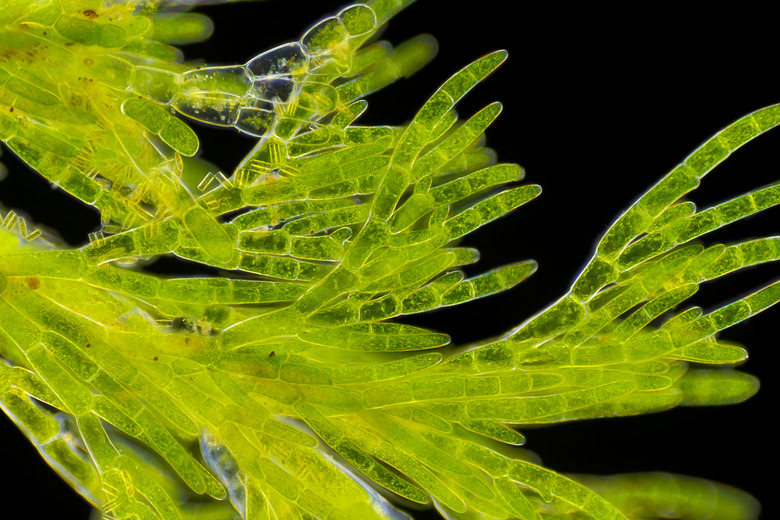What Process Is Responsible For Producing Most Of Earth's Oxygen?
The Earth's atmosphere is a gaseous mixture comprised of approximately 78 percent nitrogen, 21 percent oxygen, and trace amounts of argon, carbon dioxide, water vapor and other elements. This mixture is commonly known as air. The oxygen in the air we breathe wasn't always there – the composition of air and Earth's atmosphere has varied throughout the ages – but since the evolution of organisms that use photosynthesis the amount of available oxygen in the atmosphere has greatly increased. Plants, bacteria and other photosynthetic organisms are a major source of oxygen in the Earth's atmosphere.
What is Photosynthesis?
What is Photosynthesis?
Photosynthesis is the process plants and plantlike organisms use to make their own food from sunlight. Plants use water, carbon dioxide and sunlight to undergo photosynthesis, with glucose and oxygen as the results of the reaction.
Photosynthesis takes place within plant cells, specifically inside organelles called chloroplasts. Chloroplasts are usually located in the leaves of plants but can be present in any plant part that is exposed to sunlight. Chloroplasts contain chlorophyll, the green pigment responsible for absorbing the sun's light that the plant will use for photosynthesis.
Oxygen Is a Waste Product
Oxygen Is a Waste Product
The chemical process of photosynthesis involves combining carbon dioxide, water and sunlight to create glucose that plants use for fuel. Another product of photosynthesis is oxygen, which plants expel just as humans and other animals breathe out carbon dioxide. When plants are undergoing photosynthesis, usually during the day, they are taking up carbon dioxide and releasing oxygen into the air. That oxygen then becomes available for other organisms to use.
The expulsion of oxygen by plants through photosynthesis is the reason that there is such a large amount of oxygen in Earth's atmosphere. When plants are not undergoing photosynthesis, such as at night, they are using the process of respiration to use the glucose produced during photosynthesis to produce energy. When plans are using the process of respiration, they are producing carbon dioxide instead of oxygen.
What are Autotrophs?
What are Autotrophs?
Autotrophs are organisms that make their own food. Usually autotrophs use the process of photosynthesis to create food from sunlight – these organisms are called photoautotrophs. Another group of autotrophic organisms, chemoautotrophs (or chemotrophs), are bacteria that can use certain chemicals instead of sunlight in a process similar to photosynthesis in order to make their own food.
Autotrophs that use photosynthesis include plants, some protists (such as algae) and cyanobacteria. Most true plants are terrestrial, meaning they live on land, and include trees, shrubs, grasses and forbs. The majority of seaweeds are actually protists, although seagrass is an example of a true aquatic plant.
Marine Photoautotrophs
Marine Photoautotrophs
It is estimated that 50 to 80 percent of oxygen produced on Earth comes from the ocean as a result of photosynthesis. The majority of photosynthetic organisms in the ocean are not true plants but either algae or photosynthetic bacteria. Algae can be multicellular, such as giant kelp, or unicellular, such as diatoms.
Cyanobacteria are photosynthetic bacteria, also known as blue-green algae, that make up a large percentage of marine phytoplankton. One type of cyanobacteria, Prochlorococcus, is the smallest photosynthetic organism on Earth. It is thought that Prochlorococcus is responsible for producing 20 percent of Earth's available oxygen – more than all tropical rain forests combined!
Oxygen From the Ocean
Oxygen From the Ocean
The biomass of ocean plants and plantlike organisms is 0.005 percent of the biomass of all land plants combined. The fact that these marine photosynthetic organisms produce the majority of Earth's oxygen means that marine plants are 200 times more productive than land plants, with respect to their mass. This makes sense in terms of photosynthetically active biomass – a single-celled alga will have much more biomass dedicated to photosynthesis than a giant sequoia, with inactive heartwood and other non-photosynthetic plant parts.
Organisms in the ocean can only use photosynthesis in the presence of light. Photosynthesis in the ocean is limited to within the sunlit layer, which can reach up to 100 meters deep. Oxygen produced in this layer of the ocean is released back into the atmosphere rather quickly. Some dissolved oxygen is mixed into the deeper layers of the ocean by the rising and sinking of waters with differences in salinity and temperature.
Natural Cycles Affect Oxygen Production
Natural Cycles Affect Oxygen Production
Cycles of oxygen production by plants and plantlike organisms will vary depending on a number of variables, including nutrient availability, light, temperature and even the tides. The cycle of day and night has an effect on oxygen levels, as plants produce more oxygen during the day when light is available.
Seasonal differences in light availability and temperature will also affect the amount of oxygen that plants produce. During the winter in temperate zones, for example, oxygen production is greatly reduced as deciduous trees lose their leaves and slow or stop photosynthesis until spring.
Cite This Article
MLA
Reinbold, Joan. "What Process Is Responsible For Producing Most Of Earth's Oxygen?" sciencing.com, https://www.sciencing.com/process-responsible-producing-earths-oxygen-19636/. 30 September 2021.
APA
Reinbold, Joan. (2021, September 30). What Process Is Responsible For Producing Most Of Earth's Oxygen?. sciencing.com. Retrieved from https://www.sciencing.com/process-responsible-producing-earths-oxygen-19636/
Chicago
Reinbold, Joan. What Process Is Responsible For Producing Most Of Earth's Oxygen? last modified March 24, 2022. https://www.sciencing.com/process-responsible-producing-earths-oxygen-19636/
